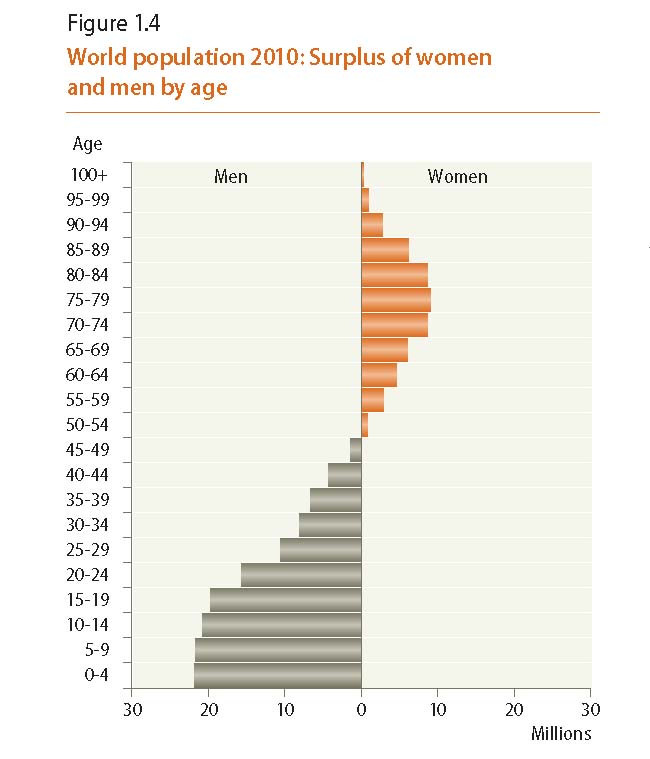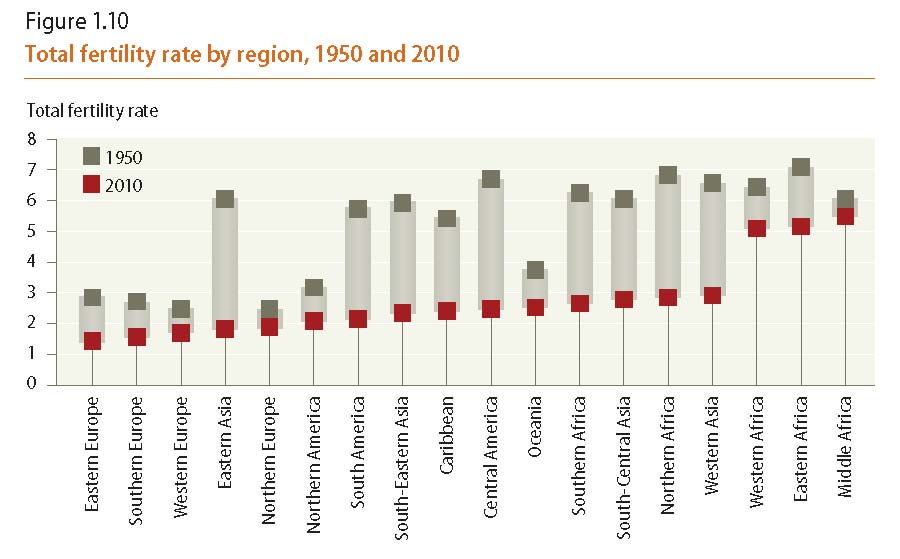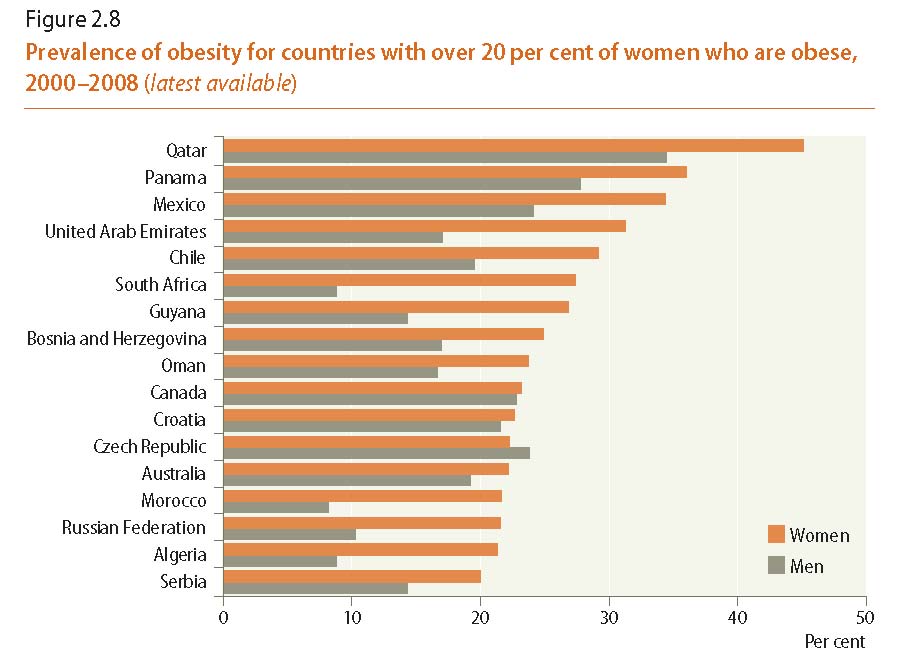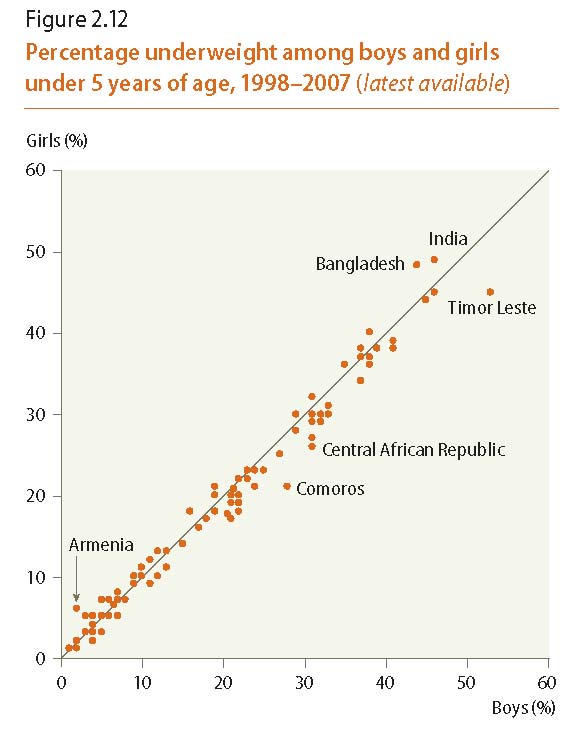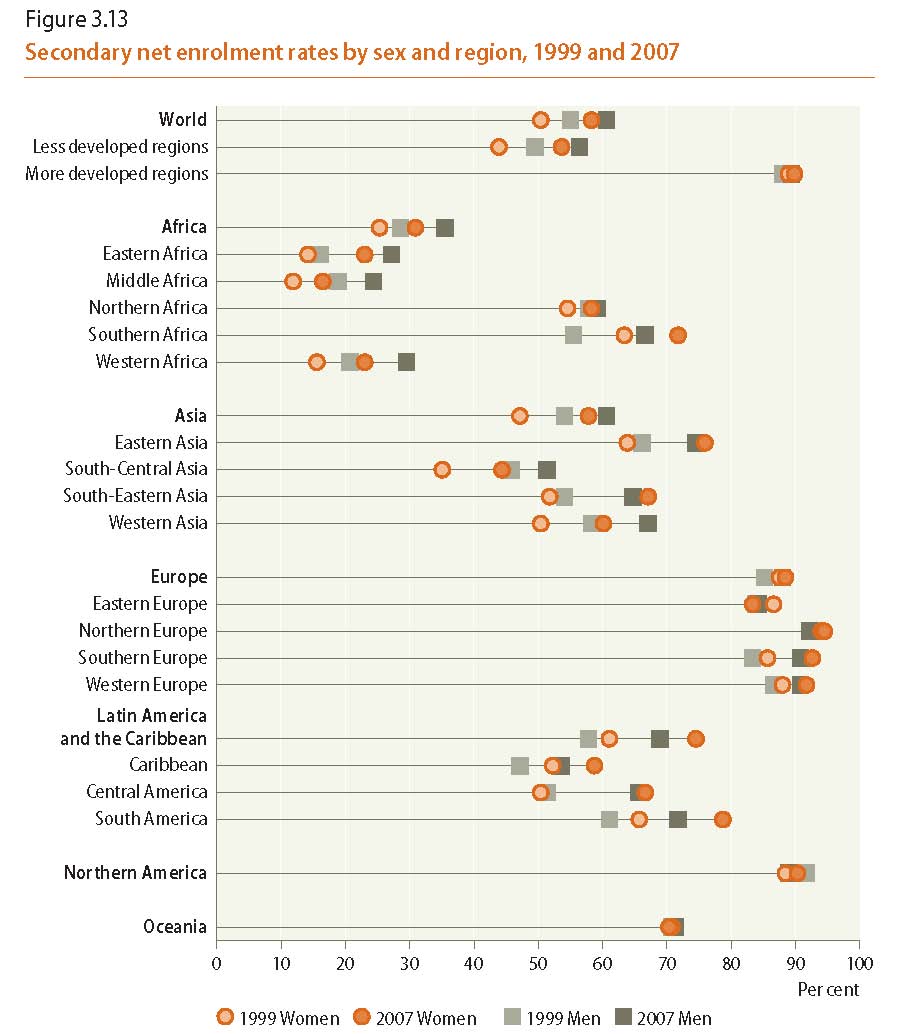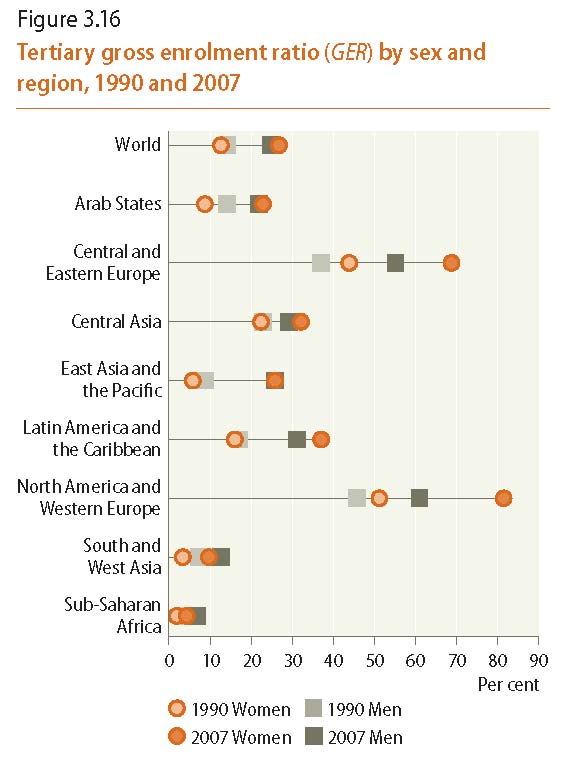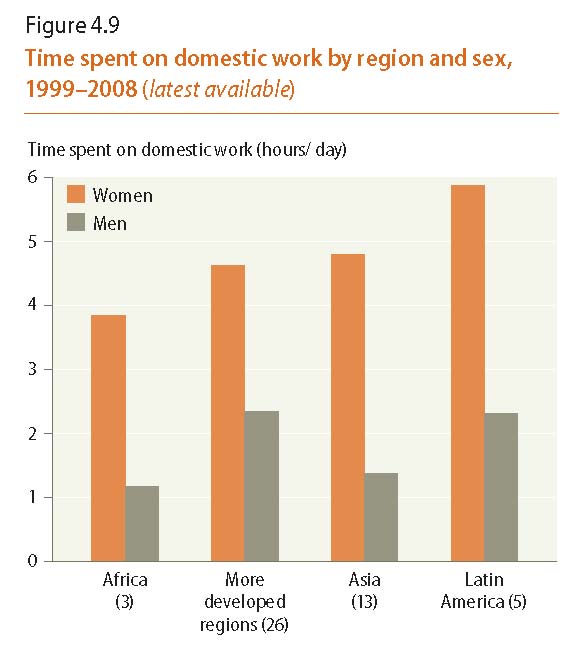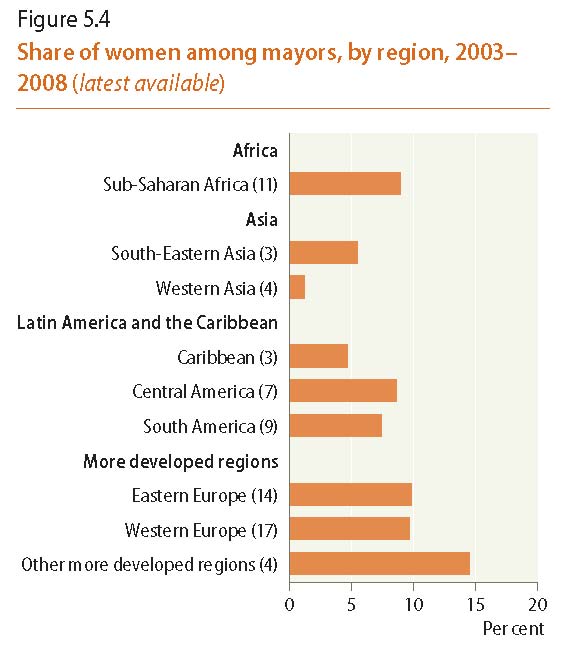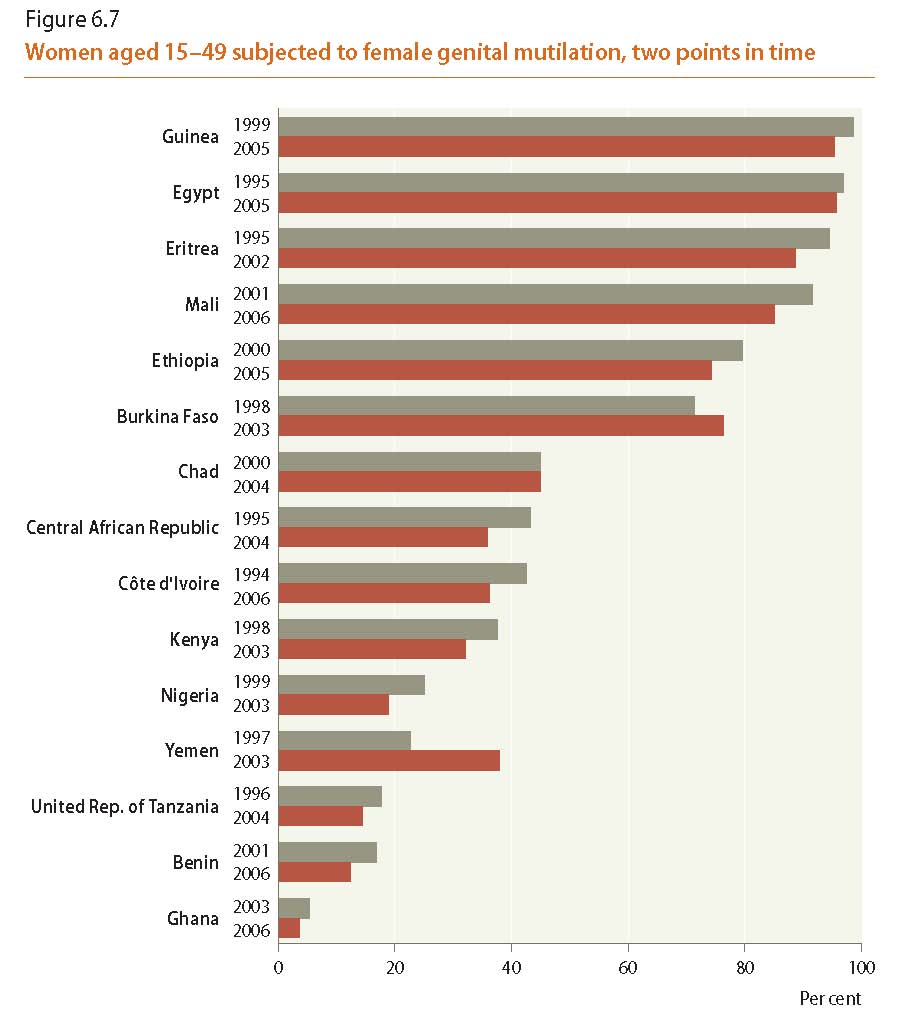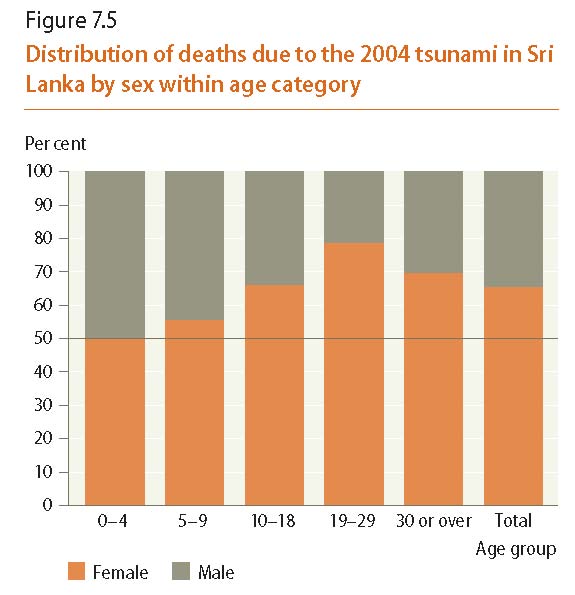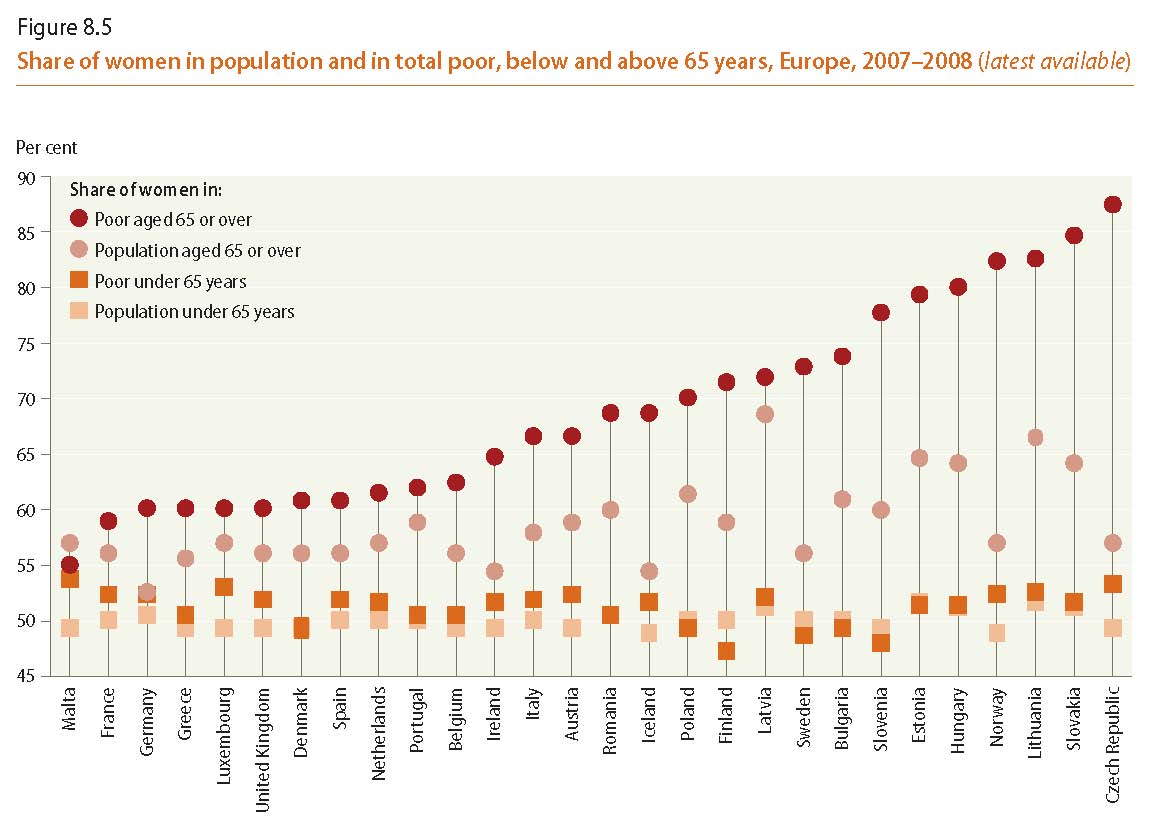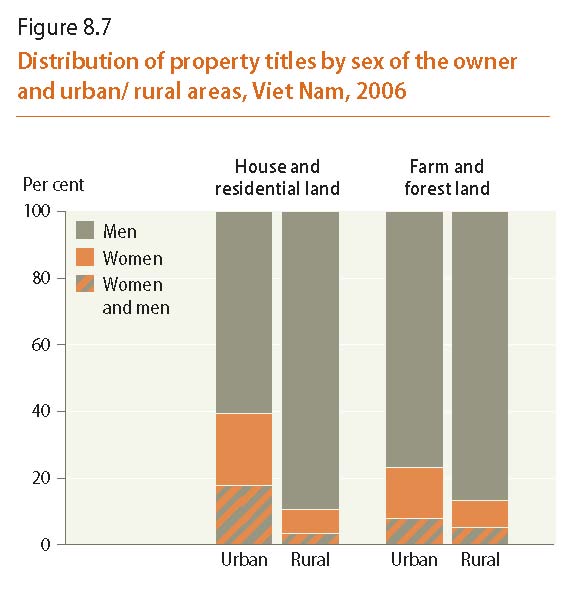The World's Women 2010: Trends and Statistics
The World's Women 2010: Trends and Statistics is the fifth issue of The World's Women and is being produced to coincide with the first-ever World's Statistics Day, 20.10.2010. The current issue highlights the differences in the status of women and men in eight areas - population and families, health, education, work, power and decision-making, violence against women, environment and poverty. Analyses are based mainly on statistics from international and national statistical sources.
The World's Women 2010 shows that progress towards gender equality has been made in some areas, such as school enrolment, health and economic participation. At the same time the report shows that much more needs to be done to close the gender gap in critical areas such as power and decision-making and violence against women
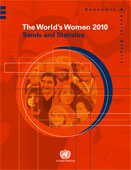
THE PUBLICATION IS NOW AVAILABLE ON APPLE'S IBOOKSTORE
Message from the Secretary - General
Download full report
- Other Languages: Arabic pdf; Chinese pdf; French pdf; Russian pdf; Spanish pdf
Media materials
- Book launch html
- Press Conference release html
- Press Release 1 Pdf
- Press Release 2 Pdf
- Press Release 3 Pdf
- Press Release 4 Pdf
- Fact sheet for Asia and the Pacific Pdf
Gender statistics sources
Executive summary
Download Executive Summary -
English* Pdf
Download full report English* -
Color Pdf,
B&W Pdf
*For printing on a non-color printer, use B/W file for better results.
In the Beijing Declaration adopted in 1995 by the Fourth World Conference on Women, participating Governments expressed their commitment "to advance the goals of equality, development and peace for all women everywhere in the interest of humanity". To assess whether these goals are being achieved, The World's Women is produced by the United Nations every five years, as called for in the Beijing Platform for Action.
The World's Women 2010: Trends and Statistics presents statistics and analysis on the status of women and men in the world, highlighting the current situation and changes over time. Analyses are based mainly on statistics from international and national statistical agencies. The report covers several broad policy areas - population and families, health, education, work, power and decision-making, violence against women, environment and poverty. The main findings are summarized below.
General population patterns, families
In today's world, there are 57 million more men than women. This surplus of men is concentrated in the youngest age groups and steadily diminishes until it disappears at about age 50, thereafter becoming a surplus of women owing to their longer life expectancy. A surplus of men characterizes the world's most populous countries - China and India - hence the large surplus of men worldwide. In most other countries, there are more women than men. The surplus of women in older age groups is significant and is increasing, with obvious implications for health care and other social needs.
People are marrying at older ages than in the past - especially women. In Europe, the average age at which women first marry is 30 or older in many countries. In some less developed countries, however, such as Mali, Niger and several other countries in sub-Saharan Africa, the average age at which women first marry is still below 20. As family-building often starts with a marriage, the consequences for fertility is obvious. Globally, fertility declined to 2.5 births per woman, but women who bear more than five children are still common in countries where women marry early. Early marriage and high fertility limit such women's opportunities for education and employment and can severely diminish their chances for advancement in life.
Once constituted, maintaining families and caring for family members lies primarily on the shoulders of women, who spend, on average, more working hours per day than men.
Health
In all regions, women live longer than men. However, social, cultural and economic factors can affect the natural advantage of women compared to men. For example, in developing countries where pregnancy and childbirth can be life-threatening, women's exposure to risks associated with pregnancy and childbirth tend to equalize life expectancies between the sexes; whereas in developed countries, the adoption of unhealthy behaviours by women, such as smoking and drinking, can also equalize life expectancy. The data reveal that, globally, non-communicable diseases are already the most important causes of death for both men and women.
Achieving the Millennium Development Goals (MDGs) that relate to health is important for improving the quality of life of all people. The past decades saw considerable reductions in child mortality worldwide, which is one of the eight MDGs. However, Africa continues to have high rates of child mortality despite intensified efforts to reduce it. Another MDG is to improve maternal health. Access to prenatal care and birth delivery attendance by skilled health personnel are essential to achieving this goal. Findings show there have been increases in the proportion of women receiving prenatal care but much still needs to be improved.
The Beijing Platform for Action recognized that social and cultural factors often increase women's vulnerability to HIV and may determine the course that the infection takes in their lives. Recent data show that in sub-Saharan Africa, North Africa and the Middle East, women account for more than half of people living with HIV/AIDS. The toll exacted by HIV/AIDS on the lives of women extends beyond their physical health to the families and communities that depend on them.
Education
There is progress - albeit slow and uneven - in the literacy status of adult women and men around the world. However, reflecting the persistent disadvantages they face, women account for two thirds of the world's 774 million adult illiterates - a proportion that is unchanged over the past two decades. Gender disparities in adult literacy rates remain wide in most regions of the world. However, there is a reason to look toward future decades with optimism as improvement in access to education eventually raises literacy levels. In almost all countries, literacy rates for the young are higher than those for adults. The vast majority of young people in the world are literate and improvements in youth literacy rates have been accompanied by declining gender disparities.
Primary enrolment of girls and boys is increasing across the world. Outstanding gains have been registered in several less developed regions of the world, particularly Africa and South-Central Asia. Yet several countries in these regions are still far from attaining universal primary education. Measurable progress has been made towards greater gender parity in primary enrolment, with gender gaps diminishing in most regions of the world. Positive global trends in primary enrolment, however, obscure uneven progress and some slippage or stagnation. While the overall progress in primary education in the past decade is encouraging, major barriers stand in the way of progress: 72 million children - 54 per cent of them girls - are out of school. The evidence indicates that much remains to be done to keep the world on track to meet the goal of universal primary education.
There is increased participation in secondary education. However, progress in secondary enrolment lags behind that in primary education. Compared to participation at the primary level, a significantly lower proportion of the official secondary-school age population attends school. In addition, gender disparities in secondary enrolment are wider and occur in more countries than at the primary level. Due to the unprecedented expansion of the tertiary student body over the past two decades, one of the most noticeable improvements in women's enrolment is registered at the tertiary level. Men's dominance in tertiary education has been reversed globally and gender disparities currently favour women, except in sub-Saharan Africa and Southern and Western Asia. The distribution of tertiary enrolment across various fields of study brings to light the gender dimension of, and inequalities in, participation in tertiary education. Gender differences in tertiary participation are apparent throughout the world, with women predominant in the fields of education, health and welfare, social sciences, humanities and art, while they remain severely underrepresented in the fields of science and engineering.
Work
Globally, women's participation in the labour market remained steady in the two decades from 1990 to 2010, hovering around 52 per cent. In contrast, global labour force participation rates for men declined steadily over the same period, from 81 to 77 per cent. In 2010, women's labour force participation rates remain below 30 per cent in Northern Africa and Western Asia; below 40 per cent in Southern Asia; and below 50 per cent in the Caribbean and Central America. The gap between participation rates of women and men has narrowed slightly in the last 20 years but remains considerable. The smallest gender gaps are in the early adult years and the widest in the prime working ages.
Employment levels in the services sector continue to grow for both women and men. In the more developed economies, the labour force - especially the female labour force - is employed predominantly in services. This sector accounts for at least three quarters of women's employment in most of the more developed regions and in Latin America and the Caribbean. In contrast, agriculture still accounts for more than half of the employment of women and men in sub-Saharan Africa (excluding Southern Africa) and of women in Southern Asia. In those regions, the majority of workers - women to a greater extent than men - are in vulnerable employment, being either own-account workers or contributing family workers.
Over the years, women have entered various traditionally male-dominated occupations. However, they are still rarely employed in jobs with status, power and authority or in traditionally male blue-collar occupations. Relative to their overall share of total employment, women are significantly underrepresented among legislators, senior officials and managers, craft and related trade workers, and plant and machine operators and assemblers; they are heavily overrepresented among clerks, professionals, and service and sales workers. Horizontal and vertical job segregation has resulted in a persistent gender pay gap everywhere. While the gender pay gap is closing slowly in some countries, it has remained unchanged in others.
In spite of the changes that have occurred in women's participation in the labour market, women continue to bear most of the responsibilities for the home: caring for children and other dependent household members, preparing meals and doing other housework. In all regions, women spend at least twice as much time as men on unpaid domestic work. Women who are employed spend an inordinate amount of time on the double burden of paid work and family responsibilities; when unpaid work is taken into account, women's total work hours are longer than men's in all regions.
Like their adult counterparts, girls are more likely than boys to perform unpaid work within their own household. In the less developed regions, many young girls aged 5-14 take on a large amount of household chores, including care-giving, cooking and cleaning, and older girls do so to an even greater extent. While boys also do household chores, their participation rate is not as high as that of girls. Moreover, girls generally work longer hours than boys, whether they are engaged in housework only, employment only or both. Long hours of work affect children's ability to participate fully in education. Analysis shows that school attendance declines as the number of hours spent on household chores increases - and declines more steeply for girls than for boys.
Power and decision-making
Around the world, a lack of gender balance in decision-making positions in government persists. Women continue to be underrepresented in national parliaments, where on average only 17 per cent of seats are occupied by women. The share of women among ministers also averages 17 per cent. The highest positions are even more elusive: only 7 of 150 elected Heads of State in the world are women, and only 11 of 192 Heads of Government. The situation is similar at the level of local government: female elected councillors are underrepresented in all regions of the world and female mayors even more so. .
In the private sector, women are on most boards of directors of large companies but their number remains low compared to men. Furthermore, the "glass ceiling" has hindered women's access to leadership positions in private companies. This is especially notable in the largest corporations, which remain male-dominated. Of the 500 largest corporations in the world, only 13 have a female chief executive officer.
Violence against women
While rates of women exposed to violence vary from one region to the other, statistics indicate that violence against women is a universal phenomenon and women are subjected to different forms of violence - physical, sexual, psychological and economic - both within and outside their homes.
Perpetrators of violence against women are most often their intimate partners. Women are abused physically and sexually by intimate partners at different rates throughout the world - yet such abuse occurs in all countries or areas, without exception. Younger women are more at risk than older women and since the consequences of such violence last a lifetime it has a severely adverse impact on women's family and social life.
Female genital mutilation - the most harmful mass perpetration of violence against women - is declining for the young girls compelled to suffer it. However, it is still reported in a number of countries at high levels.
At the same time, in many regions of the world, longstanding customs put considerable pressure on women to accept being beaten by their husbands, even for trivial reasons. Whether for burning the food, venturing outside without telling their husband, neglecting children or arguing with their husband, in quite a few countries a very high percentage of women consider such behaviour sufficient grounds for being physically hit.
Environment
Poor infrastructure and housing conditions as well as natural hazards disproportionately affect women from the less developed regions in terms of unpaid work, health and survival. More than half of rural households and about a quarter of urban households in sub-Saharan Africa lack easy access to drinking water. In most of those households, the burden of water collection rests on women, thereby reducing the amount of time they can spend on other activities, whether income-earning, educational or leisure. Lack of access to clean energy fuels and improved stoves in sub-Saharan Africa and parts of Southern and South-Eastern Asia continue to have a major impact on health. Women are more exposed than men to smoke from burning solid fuels because they spend more time near a fire while cooking and more time indoors taking care of children and household chores, thus increasing their likelihood to develop respiratory infections, pulmonary disease and lung cancer. Furthermore, several natural disasters in the less developed regions, such as the 2004 Indian Ocean tsunami, claimed more female than male lives, suggesting that more needs to be done in terms of providing equal access to information and life-skills development. All these environmental factors will continue to disproportionately affect women as long as gender-differentiated roles and expectations in the household, family and community life are maintained. At the same time, the participation of women in environmental decision-making, particularly at a high level, remains limited, thus restricting the integration of women's issues and gender perspectives into policy-making on the environment.
Poverty
In some parts of the world, women and girls are often more burdened by the poverty of their household and their environment than men and boys. At the household level, data show that certain types of female-headed households are more likely to be poor than male-headed households of the same type. In Latin America and the Caribbean and the more developed regions households of lone mothers with children have higher poverty rates than those of lone fathers with children. In the same regions, poverty rates are higher for women than for men when living in one-person households.
At the individual level, women's lack of access to and control over resources limits their economic autonomy and increases their vulnerability to economic or environmental shocks. Compared to men, lower proportions of women have cash income in the less developed regions. Existing statutory and customary laws still restrict women's access to land and other types of property in most countries in Africa and about half the countries in Asia. Moreover, significant proportions of married women from the less developed regions have no control over household spending, including spending their own cash earnings, particularly in countries from sub-Saharan Africa and Southern Asia.
Availability of gender statistics
The World's Women 2010 has benefited from an increase in the availability of gender statistics in the last 10 years. The majority of countries are now able to produce sex-disaggregated statistics on population, enrolment, employment and parliamentary representation. In addition, gender statistics in some newer areas are becoming available. For example, statistics on child labour are now collected by a larger number of countries. Similarly, surveys on time use and on violence against women were conducted in both developed and developing countries although international standards in these two statistical fields have not yet been fully developed.
At the same time, important developments with respect to some international standards and guidelines have advanced the development of gender statistics. In 2003, the definition of informal employment was adopted, paving the way for improved measurement of informal sector and informal employment. A resolution on the statistics of child labour was adopted in December 2008, thus establishing statistical measurement standards for child labour. In recent years several international standard classifications have been established by intergovernmental bodies, including those relating to occupations, economic activity, and functioning, disability and health.
However, the preparation of The World's Women 2010 was hampered by the fact that statistics in certain domains are not available for many countries. Furthermore, even the statistics that are available are often not comparable because concepts, definitions and methods vary from country to country. Data are also lacking in detail in many cases. Gender issues cannot be adequately reflected if existing sex-disaggregated statistics are classified into categories that are too broad or are not further disaggregated by relevant characteristics, such as age, residence or educational level. Finally, the quality of data varies across countries. One or more of the above-mentioned shortcomings are often encountered in data related to international migration, maternal mortality, causes of death, vocational education, access to and use of information and communication technologies, the informal sector and informal employment. The same is true of data on occupations, wages, unemployment and underemployment, decision makers in government and the private sector, and household poverty.
In other areas, the absence of internationally agreed measurement standards and methods has resulted in a lack of gender statistics relating to disease prevalence, home-based workers, access to credit, the worst forms of child labour, human trafficking, femicide, intrahousehold poverty, individual ownership of land and losses associated with natural disasters.
In conclusion, increasing the capacity to produce reliable, accurate and timely statistics, in particular gender statistics, remains a formidable challenge for many countries.
Chapter 1 - Population and families
KEY FINDINGS
The world's population tripled in the period 1950-2010 to reach almost 7 billion.
There are approximately 57 million more men than women in the world, yet in most countries there are more women than men.
There is a "gender spiral", with more boys and men in younger age groups and more women in the older age groups.
Fertility is steadily declining in all regions of the world, though it still remains high in some regions of Africa.
Life expectancy is steadily rising, with women living longer than men.
International migration is increasing. There are more and more women migrants, and in certain areas they outnumber men.
The age at marriage for women continues to rise - and it remains high for men.
In family life women overwhelmingly carry the workload, although in some countries the gap has narrowed significantly.
DOWNLOAD CHAPTER 1
Full textEnglish*: Color Pdf, B&W Pdf
Statistical Annex:
Table 1.A: Excel, Pdf
DOWNLOAD FULL REPORT
Color Pdf, B&W Pdf*For printing on a non-color printer, use B/W file for better results.
SELECTED VISUAL STATISTICS (CLICK ON THE GRAPH TO ENLARGE)
Source: United Nations, World Population Prospects: The 2008 Revision (2009).
Chapter 2 - Health
KEY FINDINGS
Women live longer than men in all regions.
Two out of every five deaths of both women and men in Africa are still caused by infectious and parasitic diseases.
Women are more likely than men to die from cardiovascular diseases, especially in Europe.
Breast cancer among women and lung cancer among men top the list of new cancer cases globally.
Women constitute the majority of HIV-positive adults in sub-Saharan Africa, North Africa and the Middle East.
The vast majority of the over half a million maternal deaths in 2005 occurred in developing countries.
The proportion of pregnant women receiving prenatal care is on the rise in many regions
Despite intensified efforts for reduction, Africa remains the region with the highest child mortality.
Data reveal no significant disparity in the proportion of underweight girls and boys.
DOWNLOAD CHAPTER 2
Full textEnglish*: Color Pdf, B&W Pdf
Statistical Annex:
Table 2.A: Excel, Pdf
DOWNLOAD FULL REPORT
Color Pdf, B&W Pdf*For printing on a non-color printer, use B/W file for better results.
SELECTED VISUAL STATISTICS (CLICK ON THE GRAPH TO ENLARGE)
Chapter 3 - Education
KEY FINDINGS
Two thirds of the 774 million adult illiterates worldwide are women – the same proportion for the past 20 years and across most regions.
The global youth literacy rate has increased to 89 per cent, while the gender gap has declined to 5 percentage points.
Gaps between girls' and boys' primary enrolment have closed in the majority of countries, but gender parity is still a distant goal for some.
72 million children of primary school age are not attending school, out of which over 39 million (or 54 per cent) are girls
While secondary school enrolments show improvement, fewer countries are near gender parity than for primary education.
In tertiary enrolment, men's dominance has been reversed globally and gender disparities favour women, except in sub-Saharan Africa and Southern and Western Asia.
Women in tertiary education are significantly underrepresented in the fields of science and engineering; however, they remain predominant in education, health and welfare, social sciences, and humanities and arts.
Worldwide, women account for slightly more than a quarter of all scientific researchers – an increase compared to previous decades but still very far from parity.
Use of and access to the Internet grew exponentially in the past decade, narrowing the gender digital divide - however, women still do not have the same level of access as men in most countries, whether more or less developed.
DOWNLOAD CHAPTER 3
Full textEnglish*: Color Pdf, B&W Pdf
Statistical Annex:
Table 3.A to 3.B: Excel, Pdf
DOWNLOAD FULL REPORT
Color Pdf, B&W Pdf*For printing on a non-color printer, use B/W file for better results.
SELECTED VISUAL STATISTICS (CLICK ON THE GRAPH TO ENLARGE)
Chapter 4 - Work
KEY FINDINGS
Globally, women's participation in the labour market remained steady in the two decades from 1990 to 2010, whereas that for men declined steadily over the same period; the gender gap in labour force participation remains considerable at all ages except the early adult years.
Women are predominantly and increasingly employed in the services sector.
Vulnerable employment - own-account work and contributing family work - is prevalent in many countries in Africa and Asia, especially among women.
The informal sector is an important source of employment for both women and men in the less developed regions but more so for women.
Occupational segregation and gender wage gaps continue to persist in all regions.
Part-time employment is common for women in most of the more developed regions and some less developed regions, and it is increasing almost everywhere for both women and men.
Women spend at least twice as much time as men on domestic work, and when all work - paid and unpaid - is considered, women work longer hours than men do.
Half of the countries worldwide meet the new international standard for minimum duration of maternity leave - and two out of five meet the minimum standard for cash benefits - but there is a gap between law and practice, and many groups of women are not covered by legislation.
DOWNLOAD CHAPTER 4
Full textEnglish*: Color Pdf, B&W Pdf
Statistical Annex:
Table 4.A to 4.D: Excel, Pdf
DOWNLOAD FULL REPORT
Color Pdf, B&W Pdf*For printing on a non-color printer, use B/W file for better results.
SELECTED VISUAL STATISTICS (CLICK ON THE GRAPH TO ENLARGE)
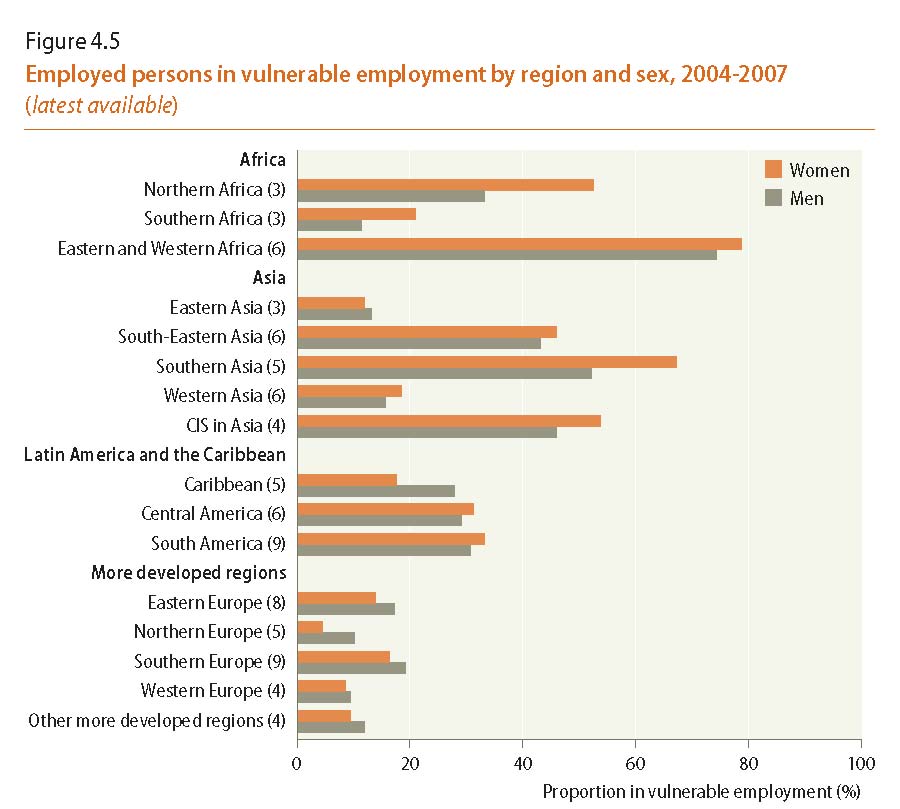
Source:Computed by the United Nations Statistics Division based on data from ILO, Key Indicators of the Labour Market, 5th edition, table 3 (accessed in July 2009).
Note: Unweighted averages; the numbers in brackets indicate the number of countries averaged. The average for Eastern Asia does not include China. Western Asia excludes Armenia, Azerbaijan and Georgia; CIS in Asia includes the aforementioned countries plus Kazakhstan, Kyrgyzstan, Tajikistan, Turkmenistan and Uzbekistan.
Chapter 5 - Power and decision-making
KEY FINDINGS
Becoming the Head of State or Head of Government remains elusive for women, with only 14 women in the world currently holding either position.
In just 23 countries do women comprise a critical mass - over 30 per cent - in the lower or single house of their national parliament.
Worldwide on average only one in six cabinet ministers is a woman.
Women are highly underrepresented in decision-making positions at local government levels.
In the private sector, women continue to be severely underrepresented in the top decisionmaking positions.
Only 13 of the 500 largest corporations in the world have a female Chief Executive Officer.
DOWNLOAD CHAPTER 5
Full textEnglish*: Color Pdf, B&W Pdf
Statistical Annex:
Table 5.A: Excel, Pdf
DOWNLOAD FULL REPORT
Color Pdf, B&W Pdf*For printing on a non-color printer, use B/W file for better results.
SELECTED VISUAL STATISTICS (CLICK ON THE GRAPH TO ENLARGE)
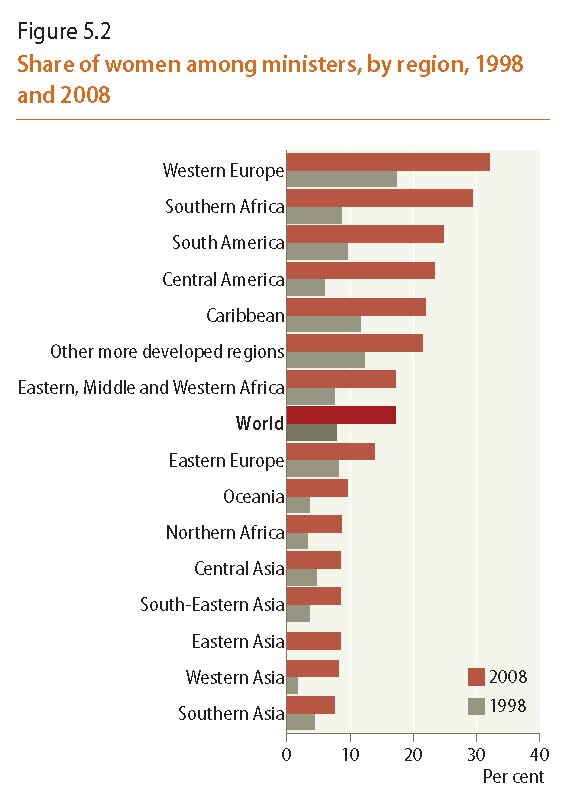
Source: Computed by the United Nations Statistics Division based on data from United Nations, The World’s Women 2000: Trends and Statistics (2000); and Inter-Parliamentary Union and United Nations Division for the Advancement of Women, Women in Politics: 2008 (2008).
Note: Unweighted averages. No data for Eastern Asia 1998.
Chapter 6 - Violence against women
KEY FINDINGS
Violence against women is a universal phenomenon.
Women are subjected to different forms of violence - physical, sexual, psychological and economic - both within and outside their homes.
Rates of women experiencing physical violence at least once in their lifetime vary from several per cent to over 59 per cent depending on where they live.
Current statistical measurements of violence against women provide a limited source of information, and statistical definitions and classifications require more work and harmonization at the international level.
Female genital mutilation - the most harmful mass perpetuation of violence against women - shows a slight decline.
In many regions of the world longstanding customs put considerable pressure on women to accept abuse.
DOWNLOAD CHAPTER 6
Full textEnglish*: Color Pdf, B&W Pdf
Statistical Annex:
Table 6.A to 6.E: Excel, Pdf
DOWNLOAD FULL REPORT
Color Pdf, B&W Pdf*For printing on a non-color printer, use B/W file for better results.
SELECTED VISUAL STATISTICS (CLICK ON THE GRAPH TO ENLARGE)
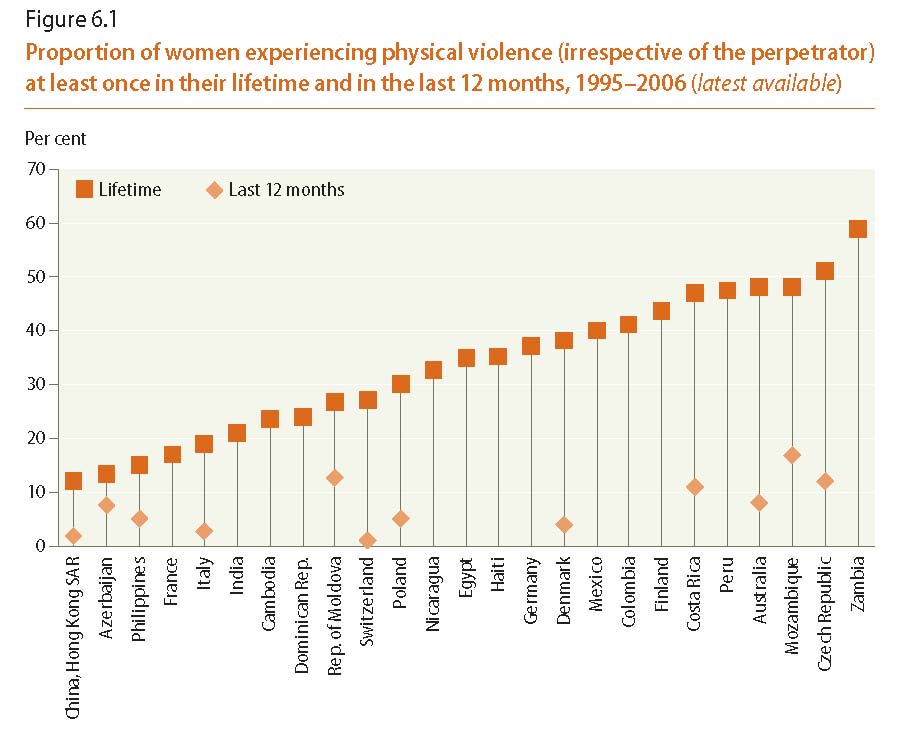
Source: Compiled by the United Nations Statistics Division from national and international surveys on violence against women.
Note: Statistics on physical violence against women in the last 12 months were not available for all the countries. Data for India and Cambodia refer to ever-partnered women. Data for Finland refer to at least one form of violence or threat.
Chapter 7 - Environment
KEY FINDINGS
More than half of rural households and about a quarter of urban households in sub-Saharan Africa lack easy access to sources of drinking water, and most of the burden of water collection falls on women.
The majority of households in sub-Saharan Africa and in Southern and South-Eastern Asia use solid fuels for cooking on open fires or traditional stoves with no chimney or hood, disproportionately affecting the health of women.
Fewer women than men participate in high-level decision-making related to the environment.
DOWNLOAD CHAPTER 7
Full textEnglish*: Color Pdf, B&W Pdf
Statistical Annex:
Table 6.A to 6.E: Excel, Pdf
DOWNLOAD FULL REPORT
Color Pdf, B&W Pdf*For printing on a non-color printer, use B/W file for better results.
SELECTED VISUAL STATISTICS (CLICK ON THE GRAPH TO ENLARGE)
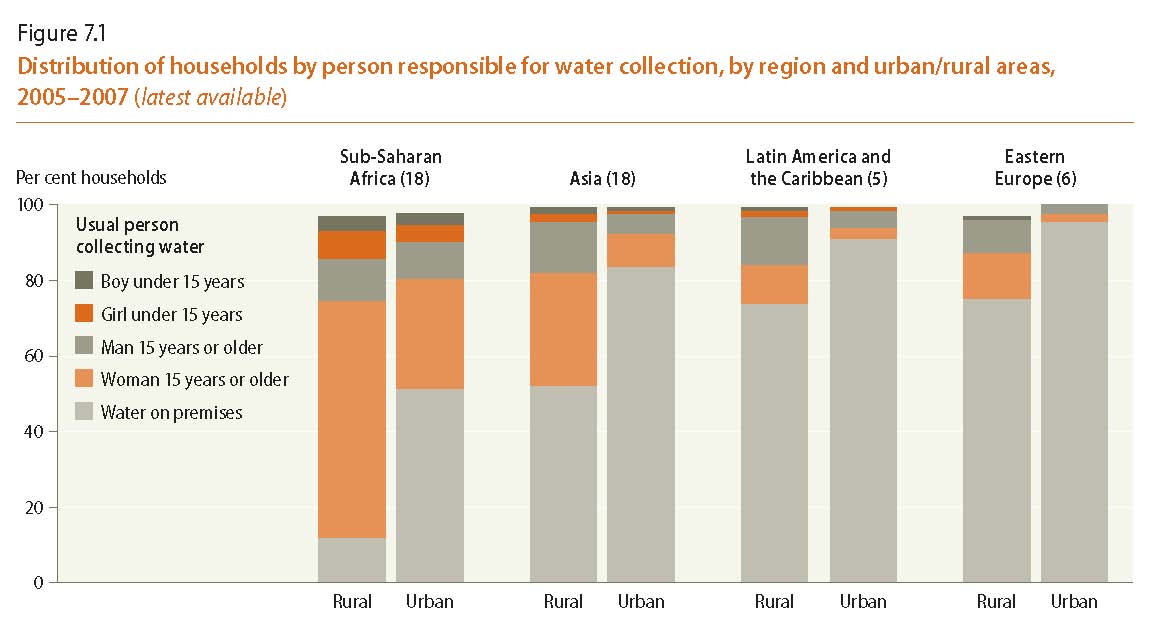
Source: Computed by the United Nations Statistics Division based on data from Macro International, Demographic and Health Survey (DHS) reports (2009) and UNICEF, Multiple Indicator Cluster Survey (MICS) reports (2009).
Note: Unweighted averages; the numbers in brackets indicate the number of countries averaged. The difference up to 100 per cent is made up by the share of households where a person from outside the household would collect the water or missing 0 information.
Chapter 8 - Poverty
KEY FINDINGS
Households of lone mothers with young children are more likely to be poor than households of lone fathers with young children.
Women are more likely to be poor than men when living in one-person households in many countries from both the more developed and the less developed regions.
Women are overrepresented among the older poor in the more developed regions.
Existing statutory and customary laws limit women’s access to land and other types of property in most countries in Africa and about half the countries in Asia.
Fewer women than men have cash income in the less developed regions, and a significant proportion of married women have no say in how their cash earnings are spent.
Married women from the less developed regions do not fully participate in intrahousehold decision-making on spending, particularly in African countries and in poorer households.
DOWNLOAD CHAPTER 8
Full textEnglish*: Color Pdf, B&W Pdf
Statistical Annex:
Table 6.A to 6.E: Excel, Pdf
DOWNLOAD FULL REPORT
Color Pdf, B&W Pdf*For printing on a non-color printer, use B/W file for better results.
SELECTED VISUAL STATISTICS (CLICK ON THE GRAPH TO ENLARGE)
Statistical Annex
The tables in the Statistical Annex display selected statistics and indicators on women and men for 196 countries or areas with a population of at least 100,000 as of 1 July 2010.
Download the Statistical Annex in one single file or individually by chapter.
All tables:
- Chapter 1 - Population and families: Table 1.A
- Chapter 2 - Health: Table 2.A
- Chapter 3 - Education: Tables 3.A to 3.B
- Chapter 4 - Work: Tables 4.A to 4.D
- Chapter 5 - Power and decision-making: Table 5.A
- Chapter 6 - Violence against women: Tables 6.A to 6.E
- Chapter 7 - Environment: Table 7.A
- Chapter 8 - Poverty: Table 8.A
